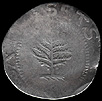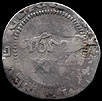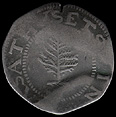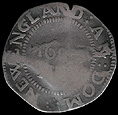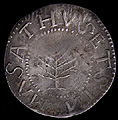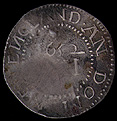Pine Tree Coinage, ca. 1667-1682
Large Planchet Shillings
obverse |
|
reverse |
| |||
1652 Noe 1 MA Pine Tree Shilling - large planchet
Obverse: [MA]SAT[HV]SETS [. IN] [rosette of seven dots]
Reverse: NEWENGLAND [: A]N : [DO]M [rosette of nine dots] 1652 / XI[I]
Weight: 50.9 g (3.30 grams) Diameter: 26.2 mm
Comments: This specimen has been heavily clipped and so is much smaller the most large planchet shillings. This is the only large planchet variety with pellets on either side of the tree trunk. Also, when different varieties are compared it is clear the pine tree on each die was individually cut, thus each tree has several unique stylistic characteristics. I believe this is the only variety where the second limb from the bottom on the left divides into two branches. This tree has been described as smaller than the tree in other large planchet varieties (i.e. this tree does not fill the space inside the beaded circle as much as it does in other varieties). It also has a shorter ground line with four diagonal hatch marks slanting to the right, sometimes called roots (some varieties have cross hatching, or have a different direction or number of hatch marks. Noe comments that the letters are similar to those used on the late varieties of Oak Tree shillings.
On the reverse note that the W is formed by the intersection of two V's. This example is a very late state of the die as can be determined from the numerous die breaks. The N in AN shows a severe break as a large blotch extending to the beads. In early states this crack was a narrow diagonal line moving down from the final stroke of the N and crossing the second stoke just above the intersection of the two strokes. There is also a die crack from the N extending to the 2 in the date, although the area is worn on this example. Another major late die break appears at the beads below the N moving across to the 6 in the date, where it joins another die break. This other break first appears on early examples as a thin line connecting the top of the 1 to the 6. In this example the break is quite heavy, extending to the right through and beyond the top of the 6 and moving to the left of the 1 to the beaded circle. Another break appears between the E and N in ENGLAND moving from a bead near the E up to the top of the N. There are also small die cracks at the outer bow of the 6 and the inner curve at the lower portion of the 5. A smaller crack as a dot appears inside the bow of the 2. From an early stage this rocker die showed signs of problems along the center of the reverse that became progressively worse as it was used. In this very late example the cracks appear to move almost from one end of the coin to the other. The center of the reverse is well worn.
Provenance: From the Robert H. Gore, Jr. Numismatic Collection.
obverse |
|
reverse |
| |||
1652 Noe 1 MA Pine Tree Shilling - large planchet
Obverse: [M]ASATHVSETS [.] IN [rosette of seven dots]
Reverse: NEWENGLAND : AN : DOM [rosette of nine dots] 165[2]
/ X[II]
Weight: 66.7 g (4.33 grams) Diameter: 29.5 mm
Comments: This specimen has a defective planchet with a notch at 12:00 o'clock. Also, the lower right portion has been bent while the upper right portion was also bent but less seriously. Although it is more worn than the previous example it has not been clipped as much, this more of the border legend is present. It appears to be a late state of the die, almost as late as the previous example. This is the only large planchet variety with pellets on either side of the tree trunk. Also, when different varieties are compared it is clear the pine tree on each die was individually cut, thus each tree has several unique stylistic characteristics. I believe this is the only variety where the second limb from the bottom on the left divides into two branches. This tree has been described as smaller than the tree in other large planchet varieties (i.e. this tree does not fill the space inside the beaded circle as much as it does in other varieties). It also has a shorter ground line with four diagonal hatch marks, sometimes called roots, slanting to the right (the final hatch mark is worn on this specimen). Other die varieties have cross hatching, or have a different direction or number of hatch marks. Noe comments that the letters are similar to those used on the late varieties of Oak Tree shillings.
On the reverse note that the W is formed by the intersection of two V's. This example is a very late state of the die as can be determined from the numerous die breaks. The N in AN shows severe breaks, one is a large blotch in the lower right from about halfway down the final stroke extending down to the beads and extending upward in two thin lines to the outer ring of beads. In early states this crack was a narrow diagonal line moving down from the final stroke of the N and crossing the second stoke just above the intersection of the two strokes. The other major die crack in the letter covers the upper portion of the letter and moves to the outer ring of beads, there are also a few thin line cracks, it also extends from the top of the first stroke to the left of the letter. There is also a die crack from the N extending to the 2 in the date, although the area is well worn on this example. Another major late die break appears at the beads below the N moving across to the top of the 6 in the date, where it joins another die break. This other break first appears on early examples as a thin line connecting the top of the 1 to the 6. In this example the break is quite heavy, extending to the right through the top of the 6 and moving to the left of the 1 all the way to the beaded circle. Another break appears between the E and N in ENGLAND as a thin line moving from a bead near the E up to near the top of the first stroke of the N (less pronounced that in the previous example). There also appears to be a small die crack at the outer bow of the 6. The blotch at the top of the D in DOM appears to be another die crack, whereas the other cracks and marks appear to be from wear and bending. From an early stage this rocker die showed signs of problems along the center of the reverse that became progressively worse as it was used. In this very late example the cracks appear to move almost from one end of the coin to the other.
Provenance: From the Robert H. Gore, Jr. Numismatic Collection.
obverse |
|
reverse |
| |||
1652 Noe 6 MA Pine Tree Shilling - large planchet
Obverse: MASATHVSETS . IN [.] [note: the N in IN is reversed]
Reverse: NEW . ENGLAND . AN . DOM . 1652
/ XII [note: the first N in ENGLAND is reversed]
Weight: 63.6 g (4.12 grams) Diameter: 29.17 mm
Comments: This is an example of the large planchet pine tree shilling that is free of clipping. The weight is under the required 72 grains because this example was tooled. Clipping the edge of a coin to remove some silver was a common but illegal practice that was easily spotted. In order to be able to pass a coin on for full value without being suspected of clipping, some individuals would tool a coin, that is, take some silver off the surface so that the coin would have a full edge and simply appear to be worn. In this example the area at the upper part of the tree on the obverse and the lower left quadrant of the reverse have been tooled.
This variety, Noe 6, was struck from the same obverse and reverse dies as Noe 4 and Noe 5. Characteristics of the obverse die, found in all three varieties, are as follows. The obverse die has the combination of the tilted or leaning S (especially the second in MASATHVSETS) along with the backwards N in IN. On the tree only the second branch from the bottom on the right has a sprig growing from it and the third and fourth branches from the bottom on the right are quite close together. The three varieties can be distinguished in that in Noe 5 the obverse is the same as Noe 4 but weakened by use. In our example, Noe 6, the die has been recut. In this state the second S was recut so that the bottom stroke is longer and now lacks a serif, although a die break is visible just below the end on the letter. Also, the die was injured at the top so that the beads above the end of the first T and over the letters HVS in MASATHVSETS are elongated into a denticle shape. Additionally, the I in IN has been elongated, in the previous two states it was perceptibly shorter than the other letters. Also note, just under the top serif of the first S is a die break seen as a dot. Also unique to Noe 6, on the tree the fourth branch up from the bottom on the right is connected to the trunk of the tree, while on the earlier varieties using this die the branch was detached.
Characteristics identifying the reverse die, found in all three varieties, are as follows. In the legend the first N in ENGLAND is backwards. Also, both of the E's are slightly smaller than the other letters. Additionally, there is a small break in the die at the end of the 2 in the date, producing a small bump on the top near the end of the final stroke. In that same number there was some extra metal in the die on the bottom inside of the curve on the 2, this produced a void on the coin that is visible in all three varieties. The reverse die was not recut in Noe 6 but shows additional and accentuated flaws when compared with Noe 4 and Noe 5. The top of the M in DOM is now part of a serious die break running from the outer circle down both sides of the letter in a V shape to the center of the letter. This break actually runs through the letter and into the center row of beads but is it not clearly visible on this example because of the tool work. There are several smaller die breaks at the N in AN as well as a break at the inner bead that is below the final stroke of the second N in ENGLAND.
Provenance: Purchased through the Robert H. Gore, Jr. Numismatic Endowment from the EAHA auction of December 13, 1997, Lot 447.
| Pine Tree Three and Sixpence | Section Contents | Small Planchet Pine Tree Shillings |
|
For viewing tips and information on optimal computer settings click
here.
For questions or comments contact Special Collections by: |
